|
|
|
Sort Order |
|
|
|
Items / Page
|
|
|
|
|
|
|
| Srl | Item |
| 1 |
ID:
132344
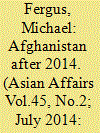

|
|
|
|
|
| Publication |
2014.
|
| Summary/Abstract |
A number of the NGOs now working in Afghanistan, like Oxfam, Afghan Aid and the Agha Khan Foundation have been there for many years and show no sign of planning to leave when NATO troops withdraw. This article is written by a committee member of the Norwegian Afghanistan Committee, which was formally established in Bergen in 1980, as a political reaction to the Soviet invasion. In 1983, the Committee started sending health workers into unoccupied areas of the country and their activities have continued ever since, though the Soviets left nearly a quarter of a century ago. The goodwill and contacts built up over time by the Committee and other NGOs have been important in validating their presence, their activities and their motives. To be useful in Afghanistan needs a commitment to the long haul.
|
|
|
|
|
|
|
|
|
|
|
|
|
|
|
|
| 2 |
ID:
132045


|
|
|
|
|
| Publication |
2014.
|
| Summary/Abstract |
During the early part of the 21st century, Chinese academic circles made judgments and forecasts about US. war aims in Afghanistan and the Middle East, the possible process of the wars, and outcomes of postwar reconstruction. After the U.S.-led attack on Afghanistan on October 7, 2001, and its military invasion of Iraq on March 20, 2003, these big events were analyzed in the context of the international politics of the time. Since these two conflicts are coming to a conclusion, at least in their direct military scope, it is time to look back upon the forecasting framework to see whether alterations and improvements can be made. On December l8, 2011, all American combat troops pulled out of lraq, and the end is in sight for U.S. withdrawal from Afghanistan-either in December 20l4, or thereafter.
|
|
|
|
|
|
|
|
|
|
|
|
|
|
|
|
| 3 |
ID:
132547
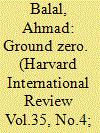

|
|
|
|
|
| Publication |
2014.
|
| Summary/Abstract |
The signing of the proposed bilateral security agreement between the US led coalition and the Afghan government is nowhere near sight, even though the declared deadline for the complete withdrawal of coalition-led forces by the end of 2014 is drawing closer everyday. This has led to a feeling of growing pessimism amongst the general public as well as those at the helm of public affairs; there is ample historic evidence to support this phenomenon. It took barely a few years for the South Vietnamese regime to fall into the hands of the North Vietnamese after the departure of US troops and drawing up on financial support, the fall of Dr. Najibullah's pro- Soviet Kabul regime to the Taliban was no different a story. While the Soviet invasion of Afghanistan was successfully thwarted when Soviet troops withdrew a decade later by an alliance whose three main partners were Saudi Arabia, Pakistan and the United States, it was the latter's unceremonious and almost sudden withdrawal from this theatre of war, which sent this region into a socio-political mayhem, which continues to date with no immediate end in sight.
|
|
|
|
|
|
|
|
|
|
|
|
|
|
|
|
| 4 |
ID:
134111
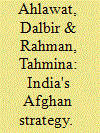

|
|
|
|
|
| Publication |
2014.
|
| Summary/Abstract |
With the deadline for the US withdrawal from Afghanistan getting closer, regional and extra-regional states have indicated pivoting their Afghan strategy. India, being an emerging power, holds much potential to contribute to the stabilisation and reconstruction of war-torn Afghanistan by developing strategic partnership with other stakeholders. For this, India's status in the regional and international system, its economic and military might and its strategy to reach beyond its traditional zone of influence warrant a systemic analysis of its Afghan strategy. The article traces the antecedents of India's current strategic and foreign policy in classical Indian strategic text Arthashstra and analyses India's present level of involvement in Afghanistan in the light of that discussion. An attempt is made in this paper to show how India's Afghan strategy is informed and influenced by its perception of allies, enemies and indifferent big powers. The paper also suggests some policy changes by critically assessing the broader context in which India operates today.
|
|
|
|
|
|
|
|
|
|
|
|
|
|
|
|
| 5 |
ID:
132094
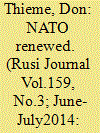

|
|
|
|
|
| Publication |
2014.
|
| Summary/Abstract |
As the NATO summit in Wales approaches, the US debate about the country's international strategy becomes more and more relevant, particularly in the light of recent developments in Eastern Europe and discussions about the role of the Atlantic Alliance post Afghanistan. Don Thieme explores some of the most pressing issues dominating this debate and suggests six reasons why the US needs to remain engaged in a renewed NATO.
|
|
|
|
|
|
|
|
|
|
|
|
|
|
|
|
| 6 |
ID:
131158
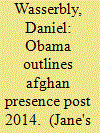

|
|
|
|
|
| Publication |
2014.
|
| Summary/Abstract |
US President Barak Obama has announced that the United States aims to keep, 9800 troops deployed in Afghanistan after the current force agreement expires at the beginning of 2015, but he would then extract most US forces before 2017.
|
|
|
|
|
|
|
|
|
|
|
|
|
|
|
|
| 7 |
ID:
130957
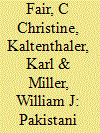

|
|
|
|
|
| Publication |
2014.
|
| Summary/Abstract |
America's Employment of Weaponized Unmanned Aerial Vehicles (Uavs), Popularly Known as "drones," to kill alleged terrorists in Pakistan's federally administered tribal areas (FATA) fuels sustained controversy in Pakistan. Pakistani outrage has steadily deepened since 2008, when the United States increased the frequency of the strikes.1 The increasing use of "signature strikes" has been particularly controversial in (and beyond) Pakistan, because such strikes are targeted at "men believed to be militants associated with terrorist groups, but whose identities aren't always known."2 Whereas personality strikes require the operator to develop a high level of certainty about the target's identity and location, based on multiple sources such as "imagery, cell phone intercepts and informants on the ground,"3 operators may "initiate a signature strike after observing certain patterns of behavior."4 When conducting signature strikes, the United States assesses that the individuals in question exhibit behaviors that match a pre-identified "signature" (for example, pattern of observable activities and/or personal networks) that suggests that they are associated with al Qaeda and/or the Pakistani or Afghan Taliban organizations.5 Because the identity of the target is unknown, even during the strike, it is possible that these persons are innocent civilians, a possibility that both current and former U.S. government officials concede.6 While the George W. Bush administration employed both personality strikes from 2004 and signature strikes from 2008 in Pakistan, the administration of Barack Obama has redoubled the use of both types.7 This has ignited public protests against the drones in Pakistan, particularly in Pakistan's urban areas-far removed from the tribal areas where drones are employed. It has also galvanized a vigorous debate within Pakistan's National Assembly, which tried, but ultimately failed, to curtail the strikes
|
|
|
|
|
|
|
|
|
|
|
|
|
|
|
|
| 8 |
ID:
131726
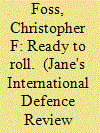

|
|
|
|
|
| Publication |
2014.
|
| Summary/Abstract |
By the end of 2014 combat operations by foreign forces in Afghanistan will have ceased and the deployed armoured fighting vehicle (AFVs) and other equipment will be on their way home.
|
|
|
|
|
|
|
|
|
|
|
|
|
|
|
|
|
|
|
|
|